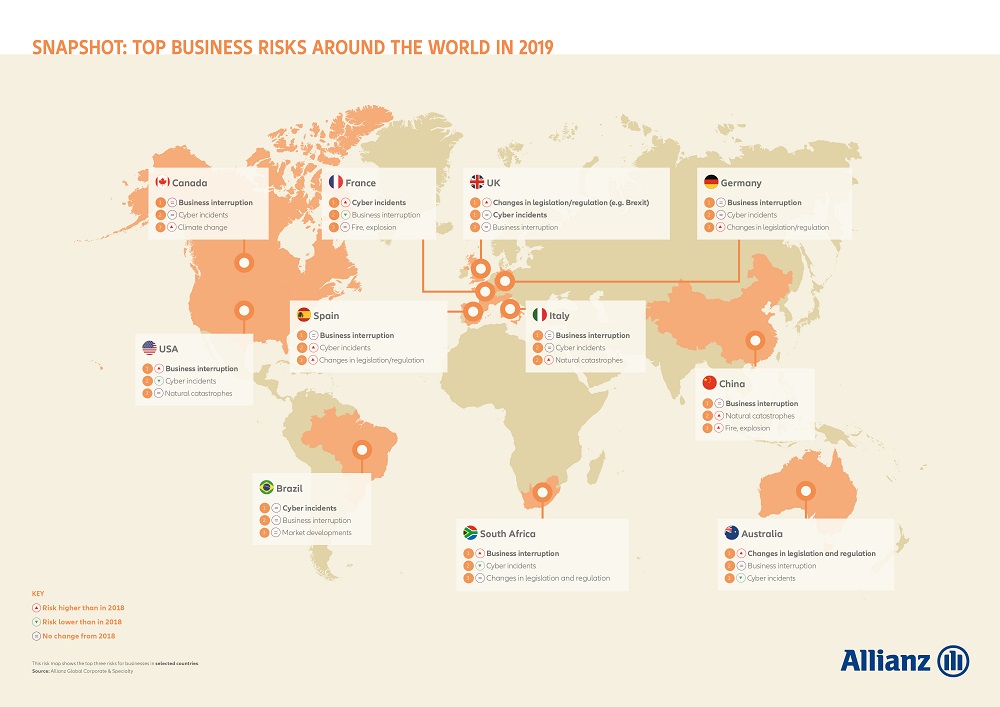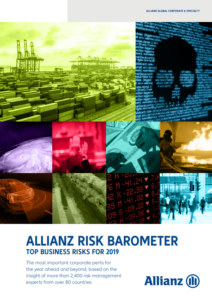Allianz issued its Risk Barometer 2019 listing the top business risks for this year. For the 2019 edition, Allianz surveyed more than 2,415 risk experts from 86 countries about the perils that worry them most. The survey identified cyber, neck-and-neck with business interruption, at the top of the Allianz Risk Barometer for the first time, while it revealed traditional risks, such as natural catastrophes, continue to be a challenge.
The list for 2019 formed as follows:
1. Business interruption (incl. supply chain disruption) 37% (2018 rank: 1)
- A consequence of many of the other top risks in the Allianz Risk Barometer, business interruption (BI) is the top threat for companies for the seventh year running (37% of responses).
- According to AGCS, the average BI property insurance claim now totals over €3mn ($3.4mn) at €3.1mn. This is more than a third (39%) higher than the corresponding average direct property damage loss (€2.2mn) with these totals significantly higher than five years ago. Losses from the largest events can be in the hundreds of millions or higher.
- Many BIs can occur without physical damage but with high losses. Events such as breakdown of core IT systems, product recall or quality incidents, terrorism, political violence or rioting and environmental pollution can bring businesses to a standstill, meaning firms may be unable to provide products and services – or customers stay away – having a devastating effect on revenues.
2. Cyber incidents (e.g. cyber crime, IT failure/outage, data breaches, fines and penalties) 37% (2018 rank: 2)
- BI is joined at the top of the ranking for the first time by cyber incidents (37%).
- According to AGCS, even the average insured loss from a cyber incident is now just over €2mn ($2.3mn) compared with almost €1.5mn from a fire/explosion incident, while losses from major events can be in the hundreds of millions or higher. Increasingly, cyber incidents bring their own BI losses.
- Respondents rank cyber as the BI trigger they fear most, given many companies’ primary assets can often be data, service platforms or groups of customers or suppliers.
- Cyber crime costs an estimated $600bn a year up from $445bn in 2014. This compares with a 10-year average economic loss from natural catastrophes of around $200bn – three times as much.
Cyber incidents are increasingly likely to spark litigation, including securities and consumer class actions…Every company needs to adopt an IT security position which is adequate to their size, operations and risk profile and invest in technological security solutions, proper backup mechanisms and staff training. The last aspect is equally important, especially for small and mid-sized enterprises, for which awareness of the growing cyber threat and its link to loss of reputation is a growing concern.
3. Natural catastrophes (e.g. storm, flood, earthquake) 28% (2018 rank: 3)
- Major events such as hurricanes Michael and Florence in North America, Typhoon Jebi in Japan and more wildfires in California brought approximately $146bn of economic losses from natural catastrophes (3rd 28%) in 2018 coming on the back of a record loss year in 2017.
- While higher than the annual average of the previous decade ($71bn), this total is down by half compared to 2017 ($150bn), which remains the costliest year on record for insurers, driven by the significant damage caused by three category 4+ hurricanes Harvey, Irma and Maria (HIM).

4. Changes in legislation and regulation (e.g. trade wars and tariffs, economic sanctions, protectionism, Brexit, Euro-zone disintegration) 27% (2018 rank: 5)
- Businesses are more concerned about changes in legislation and regulation than 12 months ago with trade wars, tariffs and ongoing uncertainty over Brexit heightening fears about the resilience of supply chains.
- 2018 was a turning point for global trade, according to Ludovic Subran, Chief Economist of Euler Hermes and Deputy Chief Economist of Allianz. US tariffs went up to 5.2% from 3.5%, bringing them back to the mid-80s and breaking with a history of preferring more sophisticated protectionism, such as regulation, over tariffs.
Yet, the end-of-year trade truce with China is only postponing growing US-China rivalry as the backdrop for multinationals in 2019. As multilateral institutions struggle for a second wind, the rules of the games will be different for companies according to their shareholders, their location or the market they are after.
5. Market developments (e.g. volatility, intensified competition/new entrants, M&A, market stagnation, market fluctuations) 23% (2018 rank: 4)
- Market developments remains a top five risk after 2018 was marked by record volatility, divergence and surprises, with more of the same expected in 2019.
- Through 2019, the cost of uncertainty will prevail, as well as rapidly changing political backdrops and possibly the return of risk of expropriation and confiscation. Market consolidation continues in vulnerable sectors (energy, machinery and equipment, retail).
6. Fire, explosion 19% (2018 rank: 6)
- AGCS research shows that fire and explosion incidents cause the largest claims for insurers and the businesses they cover.
- Such events account for almost a quarter (24%) of the value of more than 470,000 corporate insurance industry claims analyzed over a five-year period up to 2018, compared with the second major cause of loss which is aviation collision/crash (14%).
- This means that fire and explosion incidents such as building/factory fires, electrical fires and gas explosions (but not including wildfires) have caused in excess of €14bn ($15.9bn) worth of insurance losses from more than 9,500 claims and are responsible for more than half (11) of the 20 largest non-natural catastrophe loss events analyzed over the past five years.
As industries such as manufacturing have become more efficient, values at risk per square meter have risen exponentially meaning claims and losses are much more expensive than a decade ago. Even the average claim from a fire/explosion incident totals almost €1.5mn at €1.47mn today.
7. New technologies (e.g. impact of increasing interconnectivity, nanotechnology, artificial intelligence, 3D printing, autonomous vehicles, blockchain) 19% (2018 rank: 7)
- New technologies present fantastic opportunities for business, including new ways to manage risk.
- However, as the number of connected machines increase it also brings questions around security, data protection, business continuity and third party liability, as well as the potential for critical infrastructure breakdown.
- Unexpected consequences continue to materialize, such as drone activity cancelling some 1,000 aircraft at the UK’s Gatwick airport in December 2018.
8. Climate change/increasing volatility of weather 13% (2018 rank: 10)
- Respondents are concerned that recent activity could be a harbinger of increasing financial losses and disruption ensuring climate change rises to its highest-ever position.
- In addition to damage and disruption to property, climate change is likely to have big implications for regulation and liability.
- Emissions targets are already shaping industries like aviation and shipping. Growing reporting and disclosure requirements will increase exposures for companies and directors and officers.
9. Loss of reputation or brand value 13% (2018 rank: 8)
- Meanwhile, product recalls, cyber incidents and executive conduct have all tainted the reputations of organizations in recent years, affecting airlines, car manufacturers, banks and charities meaning protecting against loss of reputation or brand value takes on urgency in the social media age when crises spread rapidly.
10. Shortage of skilled workforce 9% (2018 rank: 15)
- Shortage of skilled workforce appears in the top 10 global risks for the first time with factors such as changing demographics, and Brexit contributing to its rise.
Explore more by reading the full report:




























































